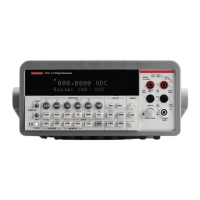Signal switching
Signal switching for DCV and OHMS is done by the DCV & Ohms Switching circuit. FETs
Q113, Q105, Q104 and Q108 connect the DCV or ohms signal to the
×
1 buffer (U113). (Tables
2-5 through 2-8 show the switching states of these FETs for the various DCV and OHMS ranges.)
Note that the reference current for OHMS is generated by the Ohms I-Source circuit. For 4-
wire ohms measurements, SENSE LO is connected to the circuit by turning on Q121.
Signal switching and gain for ACV, FREQ and ACA is done by the AC Switching & Gain
circuit, which is primarily made up of K102, U102, U103, U105, U112, U118, U111 and U110.
Tables 2-6 and 2-11 show the switching states for these AC signals. Note that U111 is used for
frequency adjustment. The states of these analog switches vary from unit to unit.
Multiplexer and A/D converter
All input signals, except FREQ, are routed to the A/D MUX & Gain circuit. The multiplexer
(U163) switches the various signals for measurement. In addition to the input signal, the multi-
plexer also switches among reference and zero signals at various phases of the measurement cycle.
When the input signal is selected by the MUX, it is amplified by U132 and U166. Tables 2-
12 through 2-16 identify the input signal lines (S3, S4, S6 or S7) of the multiplexer for the var-
ious functions and ranges. These tables also provide the switch states of U129, which determine
the gain for U132 and U166.
The multiplexed signals of the measurement cycle are routed to the A/D Converter (U165)
where it converts the analog signals to digital form. The digital signals are then routed through
an opto-isolator to the MPU to calculate a reading.
2-10 Troubleshooting

